How to Master E-Commerce Customer Support with Simple Tips

Exceptional e-commerce support is the cornerstone of any thriving online business. It’s the key to keeping your customers satisfied and encouraging repeat purchases. Did you know that 68% of consumers consider customer service agents vital for a positive shopping experience? Moreover, businesses that prioritize enhanced e-commerce support can achieve revenue growth of 4% to 8% above their market average. Even small changes, such as improving customer retention by just 5%, can lead to a remarkable 95% increase in profits.
Implementing straightforward strategies, like providing self-service options or regularly training your team, can yield substantial results. Companies that focus on these customer service enhancements often experience significant growth. By leveraging tools like Sobot to optimize your operations, you can deliver seamless support that fosters customer loyalty and propels your business toward success.
Understanding E-Commerce Customer Support
What Is E-Commerce Customer Support
E-commerce customer support is all about helping your customers navigate their online shopping experience. Whether they’re asking questions about products, troubleshooting issues, or seeking updates on their orders, your support team is there to assist. It’s not just about answering queries—it’s about creating a smooth and enjoyable experience that keeps customers coming back.
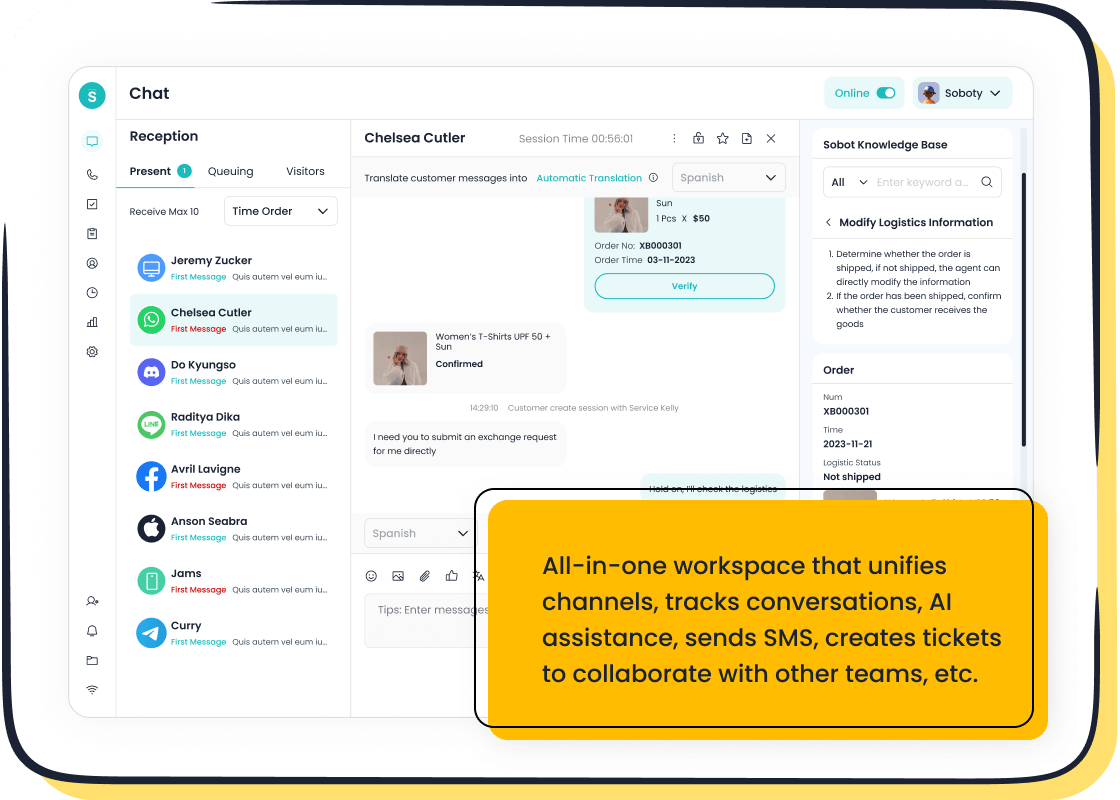
In e-commerce, support happens across multiple channels, like live chat, email, social media, and even phone calls. Tools like Sobot Live Chat make it easier to manage these interactions by unifying them into one workspace. This ensures you can respond quickly and efficiently, no matter where your customers reach out.
Why E-Commerce Support Is Crucial for Business Success
Your e-commerce customer service plays a huge role in shaping your business’s reputation. When you deliver excellent support, you build trust and loyalty. Did you know that 93% of shoppers are likely to make repeat purchases from brands that provide great service? That’s a powerful reason to prioritize customer satisfaction.
Good support also drives growth. For example, businesses that use statistical analysis, like chi-square tests, can uncover insights to improve their strategies. This leads to better decision-making and happier customers. Plus, 90% of consumers say customer service influences their decision to engage with a brand. By understanding their needs and resolving issues effectively, you set your business up for long-term success.
Common Challenges in E-Commerce Customer Support
E-commerce support isn’t without its hurdles. One major challenge is cart abandonment, which affects 59.2% to 79.8% of shoppers. Poor customer service can also drive customers away—60% of consumers have deserted a brand because of it.
Another issue is balancing automation with human interaction. While chatbots can handle repetitive tasks, 75% of consumers still prefer speaking to a real person. Efficiency matters too—one-third of customers value problem resolution in a single interaction. If your team struggles with response times or escalations, it can hurt your brand’s reputation.
To tackle these challenges, focus on tools that streamline your operations. Solutions like Sobot’s omnichannel platform help unify communication channels, reduce backlogs, and improve resolution times. This ensures your customers get the support they need, when they need it.
Building a Strong E-Commerce Support Strategy
Setting Clear Goals and Policies
Clear goals and policies are the backbone of a successful customer service strategy. They give your team direction and ensure consistency in how you handle customer interactions. When your team knows what’s expected, they can focus on delivering top-notch service.
Studies show that setting goals improves performance significantly. For example, over 90% of companies report better clarity and communication when they use frameworks like OKRs (Objectives and Key Results). Employees with clear goals are 3.6 times more likely to stay committed to their organization and 6.7 times more likely to feel proud of their work. These benefits translate directly into better customer experiences.
To get started, define measurable objectives for your e-commerce support. Whether it’s reducing response times or increasing customer satisfaction scores, make sure your goals align with your business vision. Pair these goals with detailed policies that outline how to handle common scenarios, like refunds or complaints. This ensures your team can act confidently and consistently, no matter the situation.
Adopting a Customer-Centric Approach
Putting your customers first is one of the best practices for ecommerce customer service. A customer-centric approach means understanding their needs, anticipating their challenges, and delivering solutions that make their lives easier.
Here’s why it works:
- Personalization creates stronger connections. Tailoring your offerings to individual preferences boosts engagement and loyalty.
- Convenience drives satisfaction. Features like one-click ordering and intuitive navigation make shopping effortless.
- Omnichannel integration ensures a seamless experience. Synchronizing inventory and customer data across platforms lets customers shop however they prefer.
- Proactive communication builds trust. Using AI tools to anticipate needs and offer solutions before issues arise strengthens relationships.
Metrics like Customer Satisfaction Score (CSAT) and Net Promoter Score (NPS) show how impactful this approach can be. Higher satisfaction leads to increased retention and revisit rates. For example, businesses that prioritize service quality often see a significant rise in customer loyalty.
Sobot’s solutions, such as its omnichannel platform, make adopting a customer-centric strategy easier. By unifying communication channels and leveraging AI-driven insights, you can deliver personalized and proactive support that keeps your customers happy.
Offering Multi-Channel Support Options with Sobot Live Chat
Multichannel support is no longer optional—it’s essential. Customers expect to reach you on their preferred platforms, whether it’s social media, email, or live chat. Offering multichannel support ensures you’re always accessible, which improves satisfaction and retention.
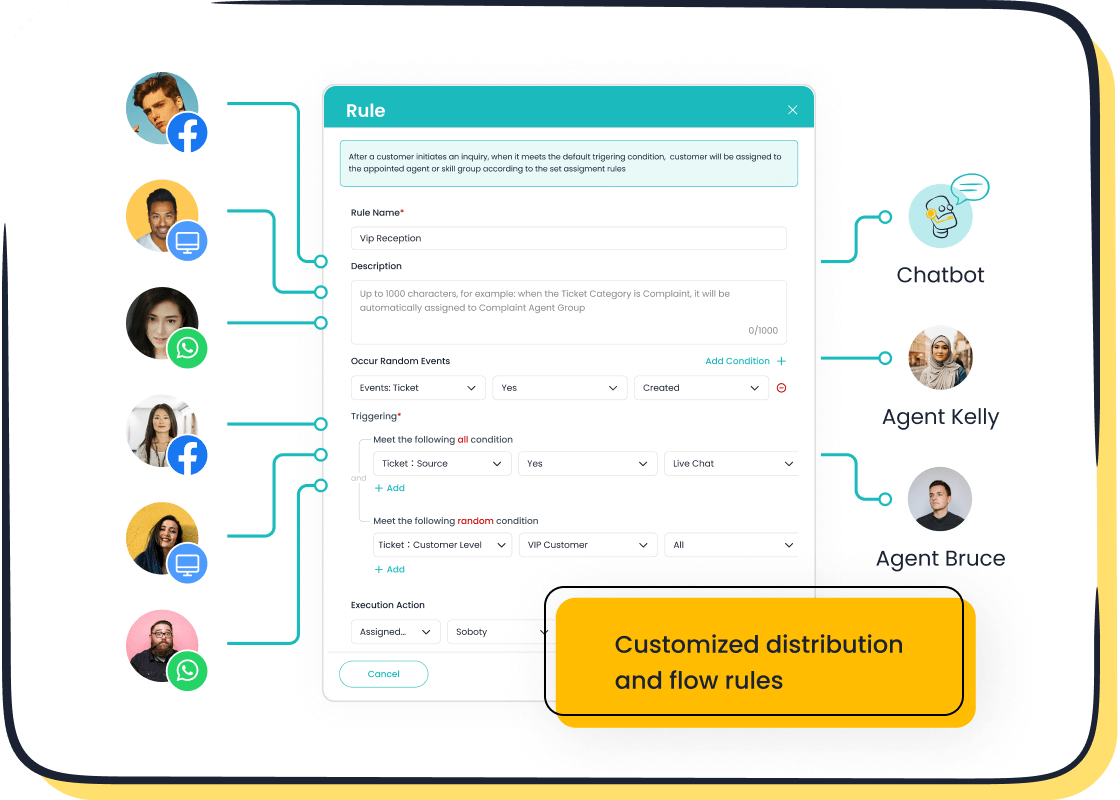
Sobot Live Chat is a powerful tool for managing multichannel support. It consolidates interactions from websites, apps, and social media into one workspace, making it easier for your team to respond quickly. With features like AI-assisted tools, auto-translation, and customizable widgets, Sobot Live Chat enhances efficiency and ensures no customer query goes unanswered.
The impact of multichannel support is undeniable. Businesses using tools like Sobot Live Chat report:
| Metric | Impact |
|---|---|
| Reduction in inbound discussion volume | 20% reduction over two years |
| Customer satisfaction score | 96% positive feedback |
| Correct answers rate | Over 80% |
| Customer satisfaction | Over 95% satisfied |
| Self-service question resolution | 22.2% of questions answered by AI |
| Problem resolution rate | 85% of problems solved |
| Customer happiness | 99% happy customers |
| Sign-off rate | Increased by 35% |
| COD collection rate | Increased by 40% |
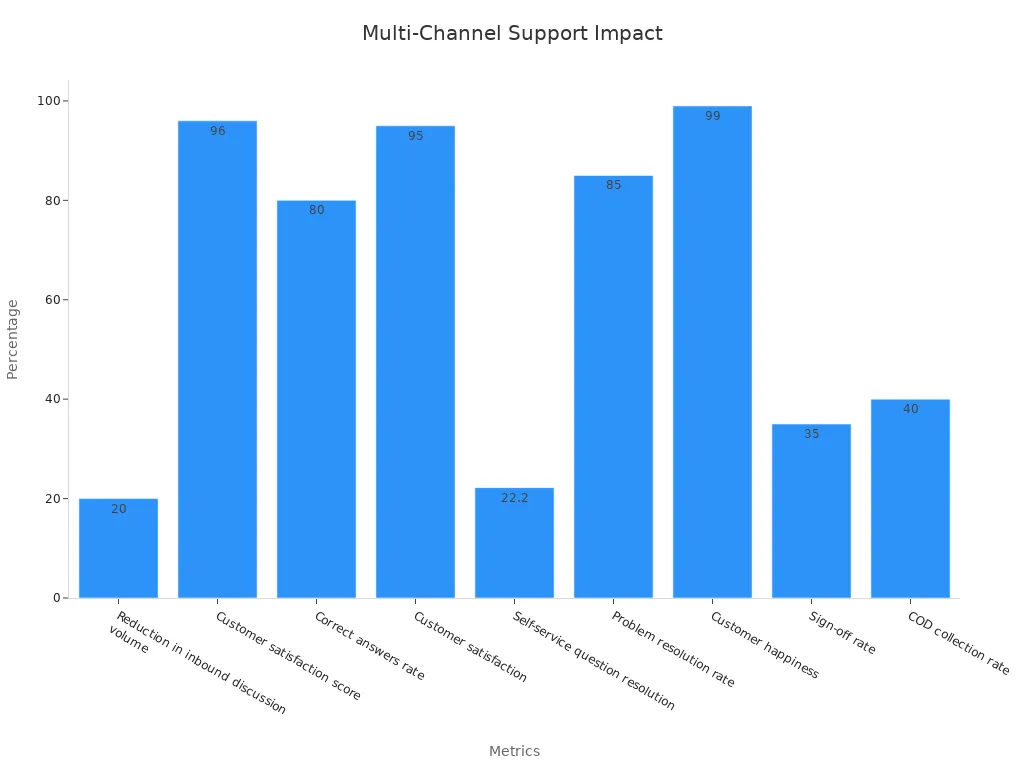
By offering multichannel support, you not only meet customer expectations but also improve operational efficiency. Tools like Sobot Live Chat help you deliver faster responses, resolve issues effectively, and create a seamless experience across all platforms.
Leveraging Technology for Effective Customer Support

The Role of Live Chat in E-Commerce Customer Service
Live chat has become a game-changer in ecommerce customer service. It allows you to connect with your customers instantly, offering fast and reliable support when they need it most. Unlike traditional methods like email or phone calls, live chat provides real-time assistance, which can significantly improve customer satisfaction.
Did you know that 73% of customers prefer live chat for communication? It’s no surprise, considering the convenience it offers. Businesses that use live chat support often see a 92% satisfaction rate among users. Moreover, proactive live chat can make visitors 6.3 times more likely to complete a purchase, boosting your revenue by 48% per chat hour.
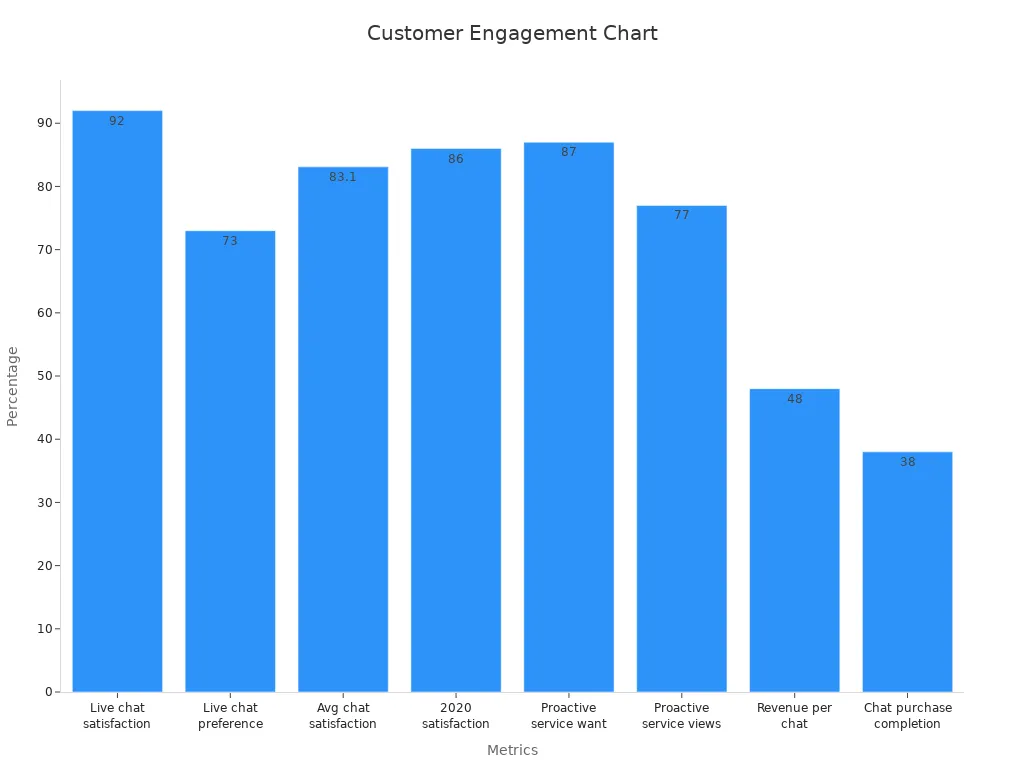
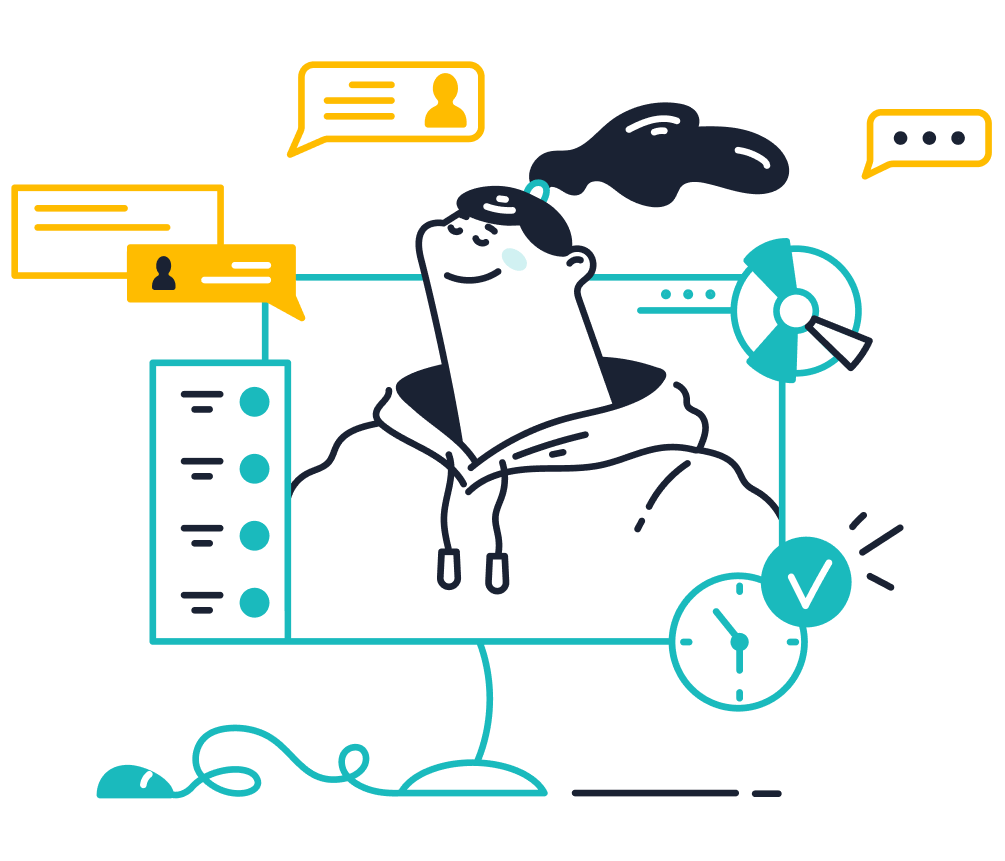
Sobot Live Chat takes this a step further by integrating AI-powered tools and omnichannel support. It consolidates interactions from websites, apps, and social media into one workspace, ensuring no query goes unanswered. With features like auto-translation and customizable widgets, you can provide personalized and seamless support to your customers. This not only enhances their experience but also builds trust and loyalty.
Automating Repetitive Tasks with AI-Powered Tools
Repetitive tasks can drain your team’s time and energy. That’s where AI-powered tools come in. They handle routine queries, freeing up your agents to focus on more complex issues. This improves efficiency and ensures your customers get the attention they deserve.
AI tools can analyze agent performance, provide real-time feedback, and even conduct root cause analysis to identify recurring issues. Traditional methods often lack these capabilities, making AI a must-have for modern customer service. For example:
- AI tools can increase the number of inquiries handled per hour by 13.8%.
- They can boost document writing efficiency by 59% and programming output by 126%.
| Study | Task Type | Efficiency Gain |
|---|---|---|
| 1 | Customer Support | 13.8% more inquiries per hour |
| 2 | Business Document Writing | 59% more documents per hour |
| 3 | Programming | 126% more projects per week |
Sobot’s AI-powered chatbot is a perfect example. It offers 24/7 customer support, resolving common questions through self-service options. This not only reduces response times but also enhances customer satisfaction. For instance, OPPO, a global smartphone brand, achieved an 83% chatbot resolution rate and a 94% positive feedback rate after implementing Sobot’s solutions.
Integrating Omnichannel Solutions for Seamless Support
Your customers interact with your brand across multiple platforms—social media, email, websites, and more. Integrating these channels into a single system ensures a seamless experience. Omnichannel support eliminates data silos, giving you a complete view of your customers’ needs and preferences.

Research shows that 44% of people stop shopping with a retailer due to poor digital experiences. By adopting omnichannel solutions, you can retain these customers and improve their journey. Sobot’s omnichannel platform excels in this area. It unifies communication channels, integrates with tools like Salesforce and Shopify, and provides AI-driven insights to optimize your operations.
With Sobot, you can offer self-service options like AI chatbots while maintaining a human touch for complex issues. This balance ensures fast and reliable support, keeping your customers happy and engaged. Whether they’re reaching out via WhatsApp, Instagram, or your website, Sobot’s solutions make it easy to deliver consistent and high-quality service.
Personalizing Customer Interactions

Using Data to Understand Customer Needs
Data is the backbone of personalized customer service. By analyzing customer behavior, preferences, and past interactions, you can anticipate their needs and deliver tailored solutions. Predictive analytics, for instance, helps forecast future trends based on historical data. Tools like Google Analytics reveal visitor behaviors, such as which products they browse most or how long they stay on your site.
Machine learning takes this a step further by identifying patterns in customer interactions. It enables you to adapt your e-commerce support strategy to meet evolving demands. For example, analyzing acquisition and engagement metrics can help you refine your approach to attract and retain customers.
Sobot’s omnichannel solution integrates customer data across platforms, giving you a unified view of their preferences. This makes it easier to craft strategies that resonate with your audience. Whether it’s through personalized recommendations or proactive outreach, data-driven insights ensure your customers feel valued.
Tailoring Responses for Better Engagement
Generic responses can alienate your customers. Tailored replies, on the other hand, show that you understand their unique concerns. Metrics like engagement rate and customer satisfaction score highlight the importance of personalized service. For instance, businesses that tailor responses often see higher conversion rates and improved customer retention.
| Metric | Description |
|---|---|
| Engagement Rate | Reflects interaction levels, including session duration and conversions. |
| Customer Satisfaction Score | Measures satisfaction with offerings, providing immediate feedback on experiences. |
| Customer Retention Rate | Indicates loyalty and engagement over time. |

Sobot Live Chat simplifies this process by equipping agents with AI-assisted tools. These tools analyze customer queries and suggest personalized responses, ensuring faster and more accurate resolutions. Features like auto-translation and rich messaging options further enhance engagement, especially for global audiences.
Building Long-Term Relationships Through Personalization
Personalized service isn’t just about solving immediate problems—it’s about fostering trust and loyalty. When customers feel understood, they’re more likely to return. Statistics show that 44% of shoppers become repeat buyers after a personalized experience. Moreover, 73% of consumers expect enhanced personalization as technology advances.
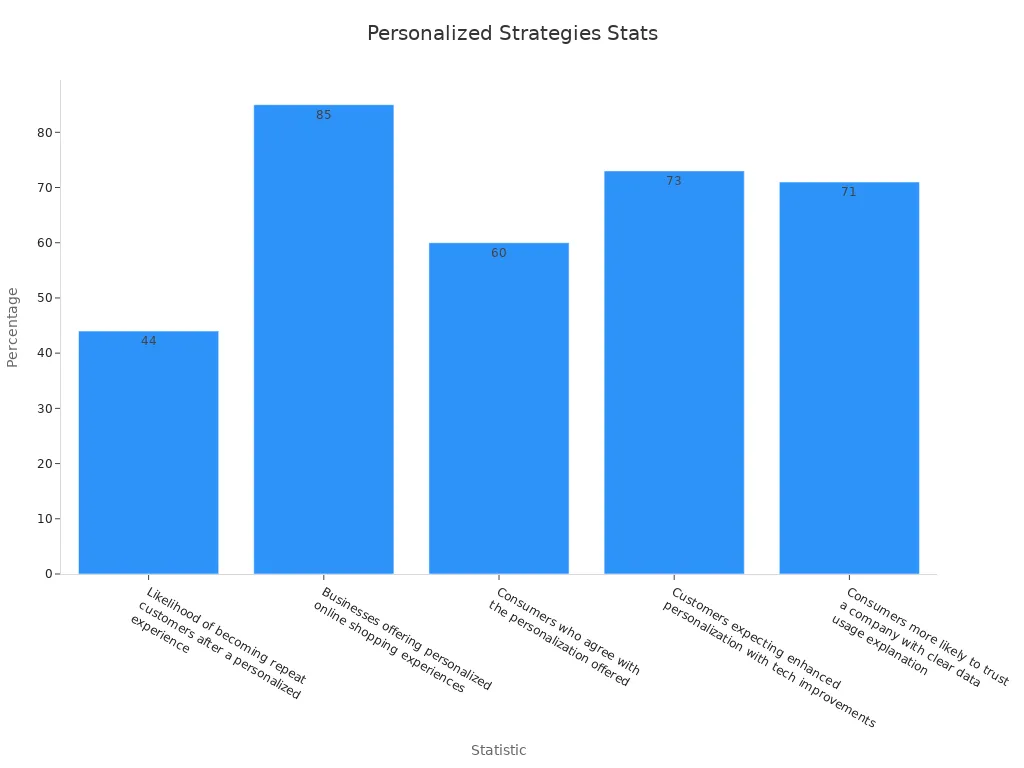
Sobot’s solutions excel in building long-term relationships. By unifying communication channels and leveraging AI-driven insights, you can offer consistent and personalized support across platforms. This approach not only boosts customer satisfaction but also strengthens loyalty, ensuring your customers stay with you for years to come.
Training and Empowering Your Support Team
Comprehensive Training for Customer Service Excellence
Your support team is the backbone of your e-commerce customer service. To ensure they excel, comprehensive training is essential. It equips them with the skills needed to handle diverse customer interactions confidently. When your team feels prepared, they can deliver exceptional service that leaves customers satisfied.
Key skills like active listening, empathy, and product knowledge are game-changers. For instance, active listening helps your team understand customer concerns better, while empathy ensures they address those concerns effectively. A well-trained team also collaborates better, leading to smoother operations and quicker resolutions.
| Key Skills Required | Impact on Customer Service |
|---|---|
| Team Collaboration | Enhances service quality |
| Active Listening | Improves customer satisfaction |
| Empathy | Addresses customer needs effectively |
| Comprehensive Product Knowledge | Increases confidence in support provided |
| Quick Response Times | Boosts customer loyalty |
Interactive training sessions can inspire your team and keep them motivated. When your staff feels valued, they’re more likely to go the extra mile for your customers.
Encouraging Empathy and Problem-Solving Skills
Empathy is the secret ingredient to building trust with your customers. When your team shows they genuinely care, it creates a positive experience that customers remember. Research even shows that empathetic communication reduces conflict and promotes healthier interactions.
Problem-solving skills are equally important. Customers appreciate quick and effective solutions. By encouraging your team to think critically, you empower them to tackle challenges head-on. This approach not only resolves issues faster but also strengthens your relationship with your customers.
Empowering Agents with Decision-Making Authority
Empowering your team to make decisions on the spot can transform your customer service. When agents have the authority to resolve issues without waiting for approvals, it speeds up resolution times and minimizes frustration for your customers.
| Empowerment Aspect | Impact on Resolution Times |
|---|---|
| Decision-making power | Reduces long call times |
| Clear issue resolution guidelines | Minimizes customer frustration |
| Defined escalation process | Enhances efficiency in handling inquiries |
Giving your team clear guidelines and the freedom to act builds their confidence. It also shows your customers that your business values their time and satisfaction. This simple step can make a big difference in creating a seamless and personalized service experience.
Avoiding Common Mistakes in E-Commerce Customer Support
Ignoring Customer Feedback
Ignoring customer feedback is one of the fastest ways to lose trust. When customers take the time to share their thoughts, they expect you to listen. If you don’t, it can lead to dissatisfaction and even drive them to competitors. For example, businesses that fail to address feedback often experience increased churn, stagnant engagement, and a damaged reputation. Worse, they miss out on opportunities to improve their services.
Consider this: customers who feel heard are more likely to return. A study found that 94% of customers whose issues were resolved said they’d shop again, compared to just 69% when their concerns were ignored. Listening to feedback isn’t just about fixing problems—it’s about showing your customers that you value them.
Delayed Response Times and Their Impact
In e-commerce, speed matters. Customers expect quick answers, and delays can cost you their loyalty. Did you know that 90% of customers value an immediate response? Yet, the average response time for customer service is over 12 hours. This gap can lead to frustration, with 60% of customers abandoning purchases due to poor service.
The financial impact is just as significant. Companies with long response times earn 45% less revenue per customer compared to those with faster support. To avoid this, focus on tools like Sobot Live Chat, which consolidates inquiries and enables real-time responses. Quick resolutions not only keep your customers happy but also encourage repeat business.
| Statistic | Value |
|---|---|
| Percentage of customers valuing immediate response | 90% |
| Average response time for customer service requests | 12 hours and 10 minutes |
| Percentage of customers abandoning a purchase due to poor service | 60% |
| Revenue difference between companies with long vs. short response times | 45% less revenue per customer |
Over-Reliance on Automation Without Human Oversight
Automation can streamline your operations, but relying on it too much can backfire. Automated systems often lack the context and empathy needed for complex issues. For instance, over-reliance on automation can lead to errors like false positives or negatives, creating a false sense of security. It can also reduce human expertise, making it harder to address unique challenges.
Take the 2017 Equifax data breach as an example. A missed patch in an automated system led to a massive security failure. While automation is a powerful tool, it works best when paired with human oversight. By combining AI-driven tools with skilled agents, you can ensure accurate, empathetic, and effective support for your customers.
Tip: Use automation for repetitive tasks but always have a human touch for complex issues. This balance keeps your customers satisfied and builds trust in your brand.
Measuring the Success of Your Customer Support Strategies
Tracking Key Metrics Like CSAT and NPS
Tracking the right metrics helps you understand how well your customer support strategies are working. Two of the most important ones are Customer Satisfaction Score (CSAT) and Net Promoter Score (NPS). These metrics give you a clear picture of how happy your customers are and how likely they are to recommend your brand.
CSAT measures how satisfied customers feel after an interaction. It’s calculated by asking questions like, “How satisfied were you with your recent purchase?” Customers respond on a 5-point or 10-point scale, and the score is expressed as a percentage.
NPS, on the other hand, focuses on loyalty. It asks, “How likely are you to recommend our company to a friend or colleague?” Customers rate their likelihood on a scale from 0 to 10. Based on their responses, they’re categorized as Promoters, Passives, or Detractors.
| Metric | Description | Scale | Calculation | Purpose |
|---|---|---|---|---|
| CSAT | Measures customer satisfaction with a product or service | 5-point or 10-point scale | (Satisfied customers ÷ Total responses) × 100 | Identify satisfaction levels |
| NPS | Measures customer loyalty and likelihood to recommend | 0-10 scale | Categorize customers into Promoters, Passives, and Detractors | Gauge loyalty and sentiment |
By keeping an eye on these metrics, you can identify areas for improvement and ensure your customers remain happy and loyal.
Monitoring Response and Resolution Times
Speed matters in customer support. Customers expect quick answers, and delays can hurt their experience. Monitoring response and resolution times helps you stay on top of this.
Response time measures how quickly your team acknowledges a customer’s query. Resolution time tracks how long it takes to fully solve the issue. Both metrics are critical for maintaining customer satisfaction. For example, 90% of customers value an immediate response, and businesses with faster support often see higher retention rates.
To improve these times, consider tools like Sobot Live Chat. It consolidates inquiries from multiple channels, enabling your team to respond faster. Quick resolutions not only keep customers happy but also encourage repeat purchases.
Analyzing Customer Retention and Loyalty Rates
Customer retention and loyalty are the ultimate indicators of your support strategy’s success. Retention measures how many customers stick with your brand over time, while loyalty reflects their willingness to choose you over competitors.
Did you know that 94% of customers who rate their experience as “very good” are likely to buy from you again? Retaining customers is also more cost-effective than acquiring new ones. By analyzing these rates, you can identify what’s working and where you need to improve.
Focus on building trust through exceptional service. Tools like Sobot’s omnichannel platform help you deliver consistent and personalized support, which strengthens loyalty. When customers feel valued, they’re more likely to stay with you and recommend your brand to others.
Mastering e-commerce customer support isn’t just a nice-to-have—it’s essential for growing your business. When you prioritize your customers’ needs, you create experiences that keep them coming back. Implementing the tips shared here, like using tools such as Sobot Live Chat, makes it easier to deliver fast and personalized service.
Great customer support builds loyalty and trust. It turns first-time buyers into lifelong customers. By focusing on their satisfaction, you’ll drive growth and set your business apart from the competition. Start today and see the difference it makes!
FAQ
1. How can Sobot Live Chat improve my e-commerce customer support?
Sobot Live Chat helps you respond faster by unifying all customer messages in one workspace. Its AI tools assist with repetitive tasks, while features like auto-translation and rich messaging ensure personalized and efficient support. This boosts customer satisfaction and loyalty.
2. What’s the difference between multichannel and omnichannel support?
Multichannel support lets you interact with customers on different platforms, but they’re not connected. Omnichannel support, like Sobot’s solution, integrates all channels into one system. This creates a seamless experience, so customers don’t have to repeat themselves when switching platforms.
3. Can automation replace human agents in customer support?
Automation handles repetitive tasks, but it can’t replace the empathy and problem-solving skills of human agents. A balanced approach works best. Use tools like Sobot’s chatbot for FAQs and let your team focus on complex issues that need a personal touch.
4. Why is customer feedback important for e-commerce businesses?
Customer feedback shows you what’s working and what needs improvement. Listening to it builds trust and loyalty. For example, addressing concerns quickly can turn unhappy customers into repeat buyers. Tools like Sobot help you track and act on feedback efficiently.
5. Is Sobot suitable for small businesses?
Absolutely! Sobot’s scalable solutions work for businesses of all sizes. Whether you’re a startup or an established brand, its tools like Live Chat and omnichannel support help you deliver excellent service without breaking the bank.
Tip: Start with Sobot’s free trial to see how it fits your needs!
See Also
Enhancing Customer Satisfaction Through Effective Live Chat Strategies
Excelling in Live Chat for Superior Customer Assistance
Guidelines for Selecting Social Media Customer Service Tools
